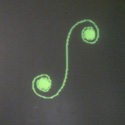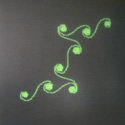LC0cO5 Make It Your Own
MAKE IT YOUR OWN
A six year old was introduced to the INSPI procedure below. When she saw it executed with these variable values, [INSPI 10 01], she declared that it looked like a “seahorse” and asked if she could have a seahorse procedure of her own. (I coded for her the equivalent SEAHORSE procedure.) Her “SEAHORSE” procedure was one she explored with considerable interest and satisfaction for several days, delighting in the pretty designs she discovered [1]:
TO INSPI : DISTANCE :ANGLE :CHANGE MAKE “ANGLE 0 FORWARD : DISTANCE TO SEAHORSE :CHANGE RIGHT :ANGLE FORWARD 10 MAKE “ANGLE (:ANGLE + :CHANGE) RIGHT :ANGLE INSPI : DISTANCE :ANGLE :CHANGE MAKE “ANGLE (:ANGLE + :CHANGE) END SEAHORSE :CHANGE END
Seahorse 1 Seahorse 7
It was important to this child to make the procedure her own because it put limits on how much complexity she had to cope with. She didn’t have to worry about other people’s procedures or how they related to hers. She created her own little world where she was free to explore and develop her own ideas.
Making things your own limits the problems you face at one time. It also serves to make you more independent. You can use your own procedure whatever way you want. You can become as certain as you need to be about how your procedure behaves. You can change your procedure without doing something unexpected to anybody else. But greater independence has its problems. You may get frustrated when your procedure doesn’t work the way you think it should; you may have a harder time explaining your own procedure to somebody when you ask them for help. Even if you begin Logo by copying others’ procedures and changing them to be exactly what you want them to be, you will soon go from changing other people’s procedures to making your own procedures from scratch.
1. This was (no surprise) Miriam, in some of The Intimate Study Logo Sessions.


